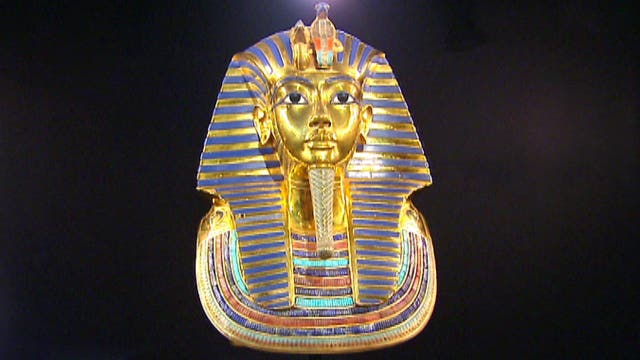The tomb of King Tut, Egypt’s short-lived ruler who marked the end of the 18th dynasty, was discovered 100 years ago.
King Tutankhamun was born in 1342 B.C. in the ancient city of Amarna, ascended to the throne and became pharaoh at the age of 9 in 1333 B.C. and ruled for 10 years until his mysterious death in 1323 B.C., according to Britannica – a fact-checked online encyclopedia.
During his decade-long reign, King Tut reportedly helped restore traditional Egyptian religion and art.
"[King Tut] issued a decree restoring the temples, images, personnel, and privileges of the old gods," Britannica reports. "He began the protracted process of restoring the sacred shrines of Amon, which had been severely damaged."
Here are 10 facts about King Tut’s tomb ahead of the archeological site’s 100th anniversary.
1. When was King Tut’s tomb built?
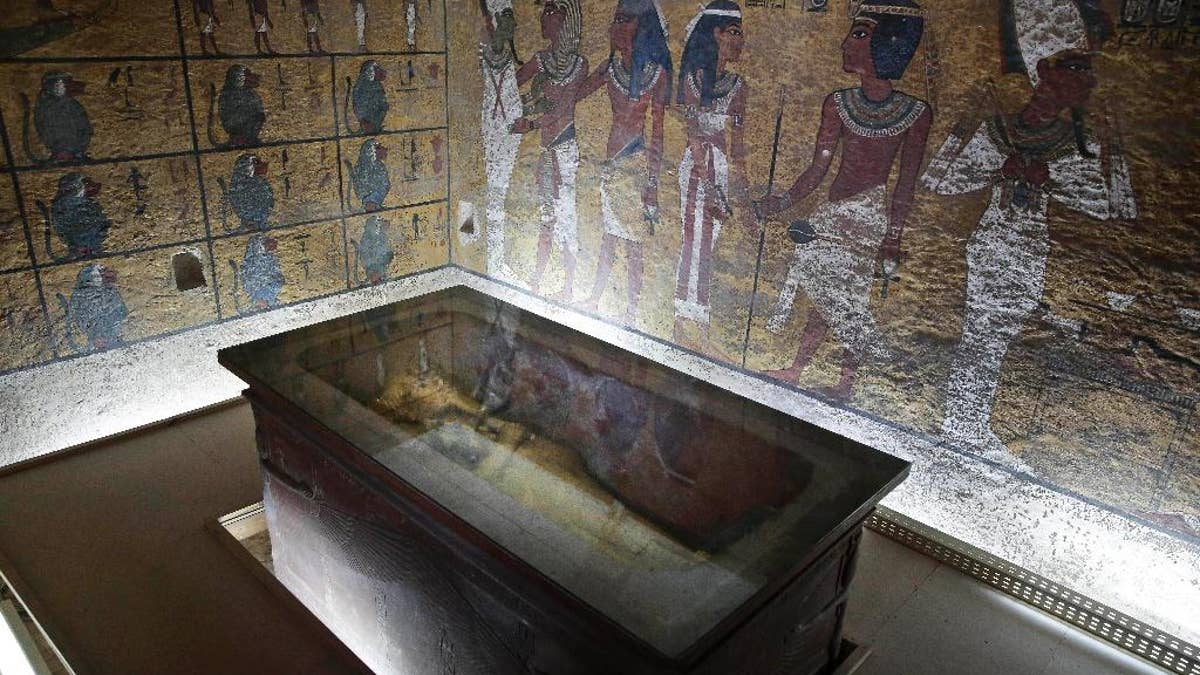
The tomb of King Tutankhamun is displayed in a glass case at the Valley of the Kings in Luxor, Egypt, Tuesday, Sept. 29, 2015. (AP Photo/Nariman El-Mofty/The Associated Press)
King Tut’s tomb is believed to have been built more than 3,000 years ago, according to National Geographic, an educational magazine that focuses on science, exploration and photojournalism.
2. How big is King Tut's tomb?
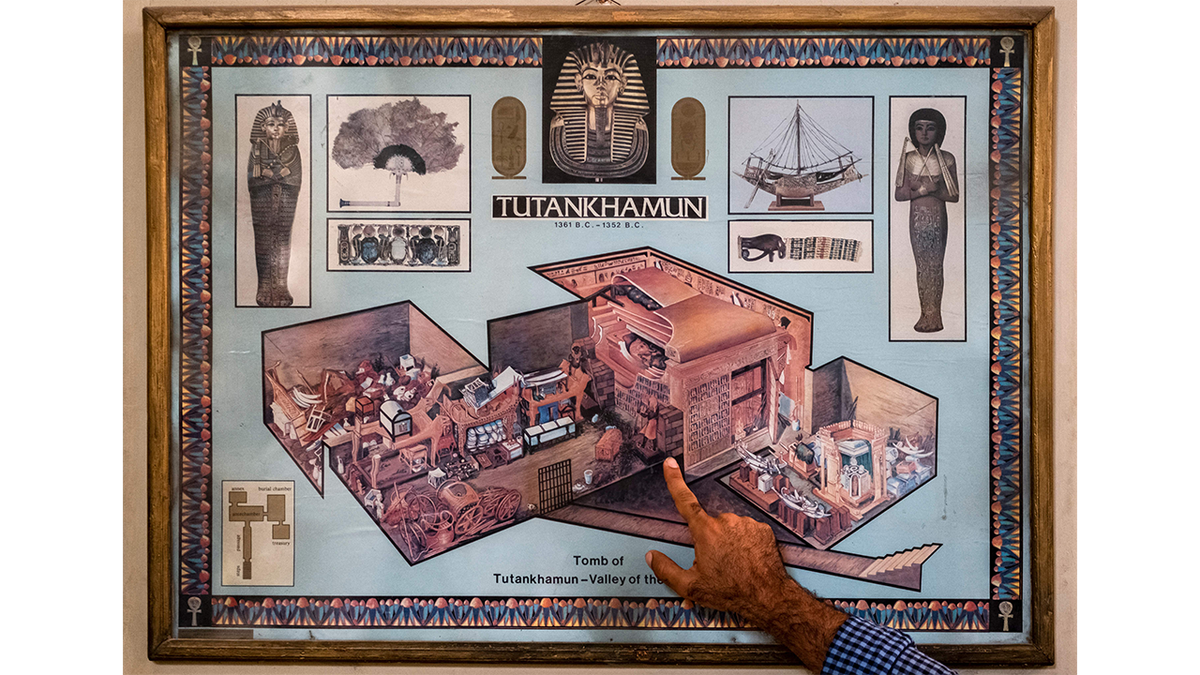
A tour guide briefs tourists before an illustration showing the state of King Tutankhamun's tomb (KV62) at the Egyptian Museum in the center of Egypt's capital Cairo on Oct. 19, 2022. (AMIR MAKAR/AFP via Getty Images)
King Tut’s tomb reportedly has five rooms, including an annex, antechamber, corridor space, treasury and burial chamber, according to various illustrations and mockups historians have shared since the tomb’s discovery.
The Egyptian Ministry of Tourism and Antiquities says the burial chamber of King Tut’s tomb measured 19.7 feet (6 meters) by 13.1 feet (4 meters) and it has a decorated rectangular outer sarcophagus that holds three nested anthropoid coffins.
KING TUTANKHAMUN BOMBSHELL? MYSTERIOUS PHARAOH MAY HAVE BEEN A BOY SOLDIER
In 2013, National Geographic reported that a replica of King Tut’s tomb measured 1,182 square feet.
3. What is it made out of?

Outside the tomb of King Tutankhamun in Egypt's Valley of the Kings back in 1922, Lord Carnavon, his daughter Lady Evelyn Herbert and archaeologist Howard Carter stand at the entrance. (Historica Graphica Collection/Heritage Images/Getty Images)
Like other pharaohs of Egypt, King Tut’s tomb was built underground in the Valley of the Kings, a royal burial ground for national leaders and powerful nobles, which is located on the west bank of the Nile River opposite the city of Luxor.
Tombs built in the Valley of the Kings from the 16th to 11th century B.C. were rock cut, according to the New World Encyclopedia, an online world history source updated by certified experts.
KING TUT TOMB MYSTERY: EXPERTS EXPLAIN STRANGE SPOTS ON BURIAL CHAMBER'S WALLS
The Egyptian Ministry of Tourism and Antiquities reports that King Tut’s sarcophagus was made out of quartzite and had four deities depicted with outspread wings on each corner.
As for the three coffins, the outer coffin is reportedly made out of gilded wood with an Osirian shape, blue and red glass ornaments and silver handles; the middle coffin is made out of gilded wood and inlaid multicolored glass; and the innermost coffin is mummy shaped and made out of solid gold, which weighs 243.4 pounds (110.4 kilograms).
4. How many objects were recovered?
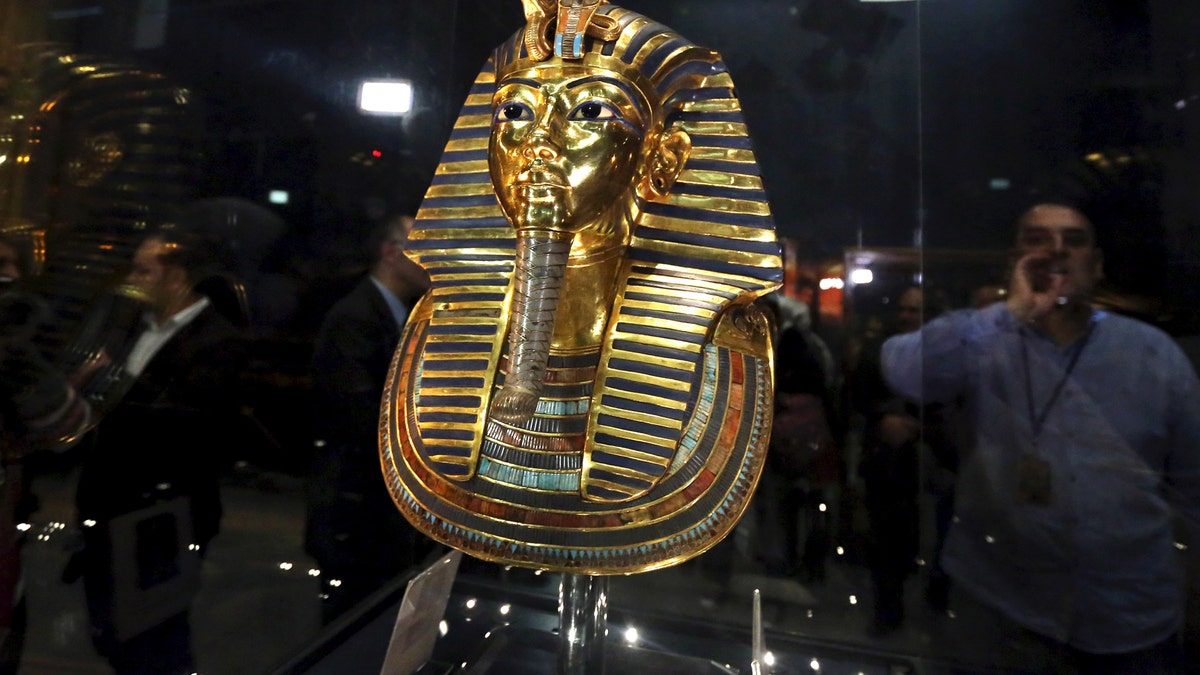
The golden mask of King Tutankhamun is displayed inside a glass cabinet at the Egyptian Museum in Cairo, Egypt, Dec. 16, 2015. (REUTERS/Mohamed Abd El Ghany)
Five thousand objects were excavated from King Tut’s tomb, according to Smithsonian Magazine, an official history and science journal published by the Smithsonian Institution in Washington, D.C.
KING TUT MYSTERY SOLVED: NO 'HIDDEN CHAMBER' IN FAMOUS TOMB, EXPERTS SAY
The objects that were reportedly found in the tomb included royal garments, gold sandals, his iconic gold mask, a cheetah skin shield and iron dagger, a granary, a collection of beer, wine, oil and tools, canopic jars storing mummified organs with an alabaster chest and 413 figurines resembling royal servants (AKA ushabti).
5. Were other people or animals found inside?
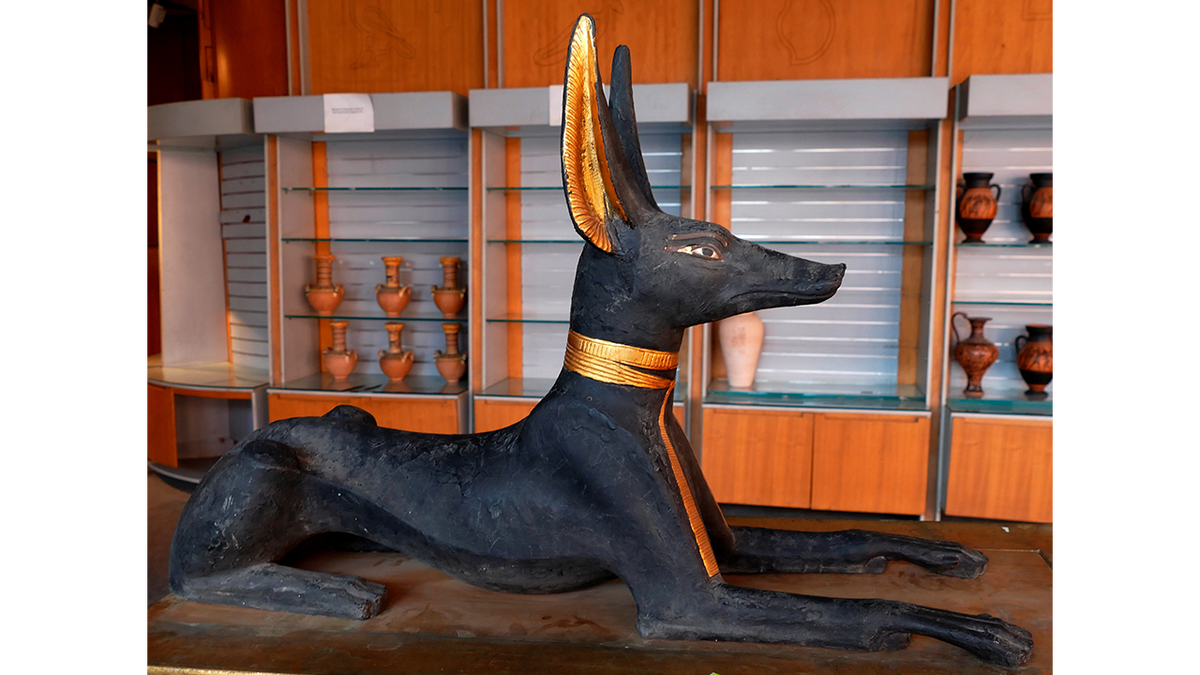
A replication of the Anubis Shrine was part of the Grave Gods of Tutankhamun. King Tut's tomb (KV62) was discovered almost intact on Nov. 4, 1922 in Egypt's Valley of the Kings. (Universal History Archive/Universal Images Group via Getty Images)
King Tut’s tomb housed several dead people, including his two stillborn daughters who are believed to have been 25 and 37 weeks when they died, according to History.com, a digital news source for the A+E Networks’ History Channel.
The cause of death is unknown, but King Tut’s daughters were reportedly found in an unmarked box that contained two wooden coffins, which each held a gilded inner coffin for the mummified remains.
King Tut was buried with his dog, Abuwtiyuw, and the animal was found in a coffin alongside fine linen, perfumed ointment and incense, according to the Orlando Sentinel, a Florida-based newspaper.
KING TUT TOMB SECRET? NEW RADAR SCAN REVIVES TALK OF QUEEN NEFERTITI’S HIDDEN BURIAL CHAMBER
The royal dog is believed to have been a hunting hound breed from Ancient Egypt, according to The Catholic University of America’s "Dogs in Ancient History" report.
Dogs in Ancient Egypt were reportedly bred to be companions and protectors.
6. Is King Tut’s tomb near other famous tombs?
King Tut’s tomb is located in the Valley of the Kings and it has been assigned the number KV62. It’s surrounded by a number of famous tombs created for other ancient Egyptian rulers.
WHAT DO KING TUT'S TOMB AND THE 21ST CENTURY HAVE IN COMMON? THE ANSWER WILL SURPRISE YOU
A detailed map published by Cleopatra Egypt Tours, a travel agency based in Giza, shows that King Tut’s tomb is near the tombs of King Ramses I (KV16), Sons of Ramses II (KV5), King Ramses IV (KV2), King Ramses IX (KV6), King Ramses II (KV7), King Akhenaton (KV55), King Merneptah (KV 8), Amenhotep II (KV 35), King Ramses VI (KV 8), King Ramses III (KV11) and King Amenmeses (KV10).
7. How much is King Tut’s tomb worth?
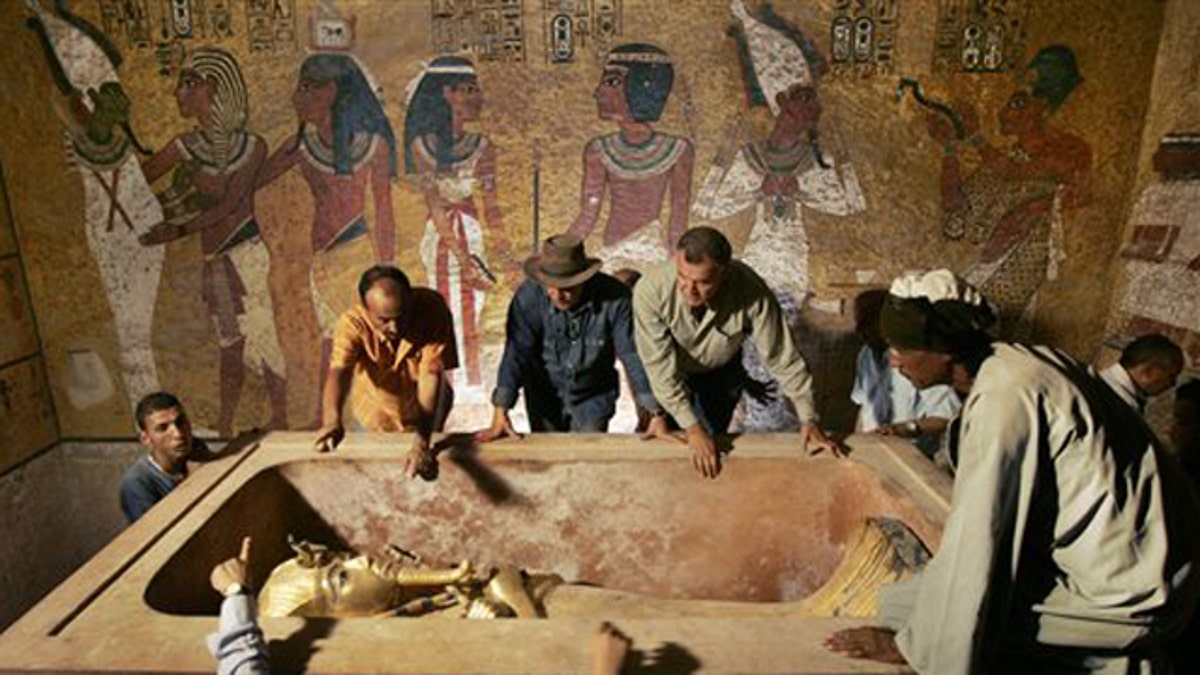
Egypt's antiquities chief Dr. Zahi Hawass (center) supervised the removal of King Tutankhamun from the stone sarcophagus in his underground tomb in the famed Valley of the Kings in Luxor, Egypt. DNA tests were performed on the world's most famous ancient king to address lingering mysteries over his lineage, said the antiquities department. (AP Photo/Ben Curtis)
The treasures found inside King Tut’s tomb are said to be worth $26 million, according to the International Centre for Settlement of Investment Disputes (ICSID), a Washington, D.C.-based international arbitration institution.
The ICSID determined the eight-figure price tag based on the reported amount museum exhibitors insured King Tut’s treasures for.
CLICK HERE TO GET THE FOX NEWS APP
"Tut’s 2,448-pound coffin would be worth about $1,700,000 at today’s prices," the ICSID wrote in a business article entitled, "How Much Money Is King Tut Worth?"
8. Who found the tomb?

British archeologist and Egyptologist Howard Carter inspects the golden sarcophagus that holds King Tutankhamon's mummy in this 1922 photograph. (Apic/Getty Images)
British archeologist Howard Carter found King Tut’s tomb on Nov. 4, 1922, according to National Geographic.
"It was a sight surpassing all precedent, and one we never dreamed of seeing," Carter reportedly wrote in a journal at the time, according to the Chicago Tribune, an Illinois-based newspaper.
FOLLOW US ON FACEBOOK FOR MORE FOX LIFESTYLE NEWS
"We were astonished by the beauty and refinement of the art displayed by the objects surpassing all we could have imagined--the impression was overwhelming," he continued.
9. Where is King Tut’s body now?

This picture taken on January 31, 2019, shows the linen-wrapped mummy of the 18th dynasty Pharaoh Tutankhamun, displayed in a climate-controlled glass case in his underground tomb (KV62) in Egypt's Valley of the Kings. The famous tomb reportedly underwent a nine-year conservation by a team of international specialists. (MOHAMED EL-SHAHED/AFP via Getty Images)
King Tut’s mummified remains are in his tomb in the Valley of the Kings, according to History.com.
The remains are reportedly stored in a climate-controlled glass box within the KV62 chamber instead of the sarcophagus and coffins that once held it.
10. Is King Tut’s tomb open to visitors?

A group of tourists take a look at Pharaoh Tutankhamun's golden sarcophagus, which is on display in the burial chamber of his underground tomb (KV62) in the Valley of the Kings. (MOHAMED EL-SHAHED/AFP via Getty Images)
King Tut’s tomb is open to visitors from 7 a.m. to 5 p.m. daily, according to the Egyptian Ministry of Tourism and Antiquities.
CLICK HERE TO SIGN UP FOR OUR LIFESTYLE NEWSLETTER
Tickets to view the tomb are approximately $12.37 (300 Egyptian pounds) for foreign adults and approximately $6.19 (150 Egyptian pounds) for foreign students.




















